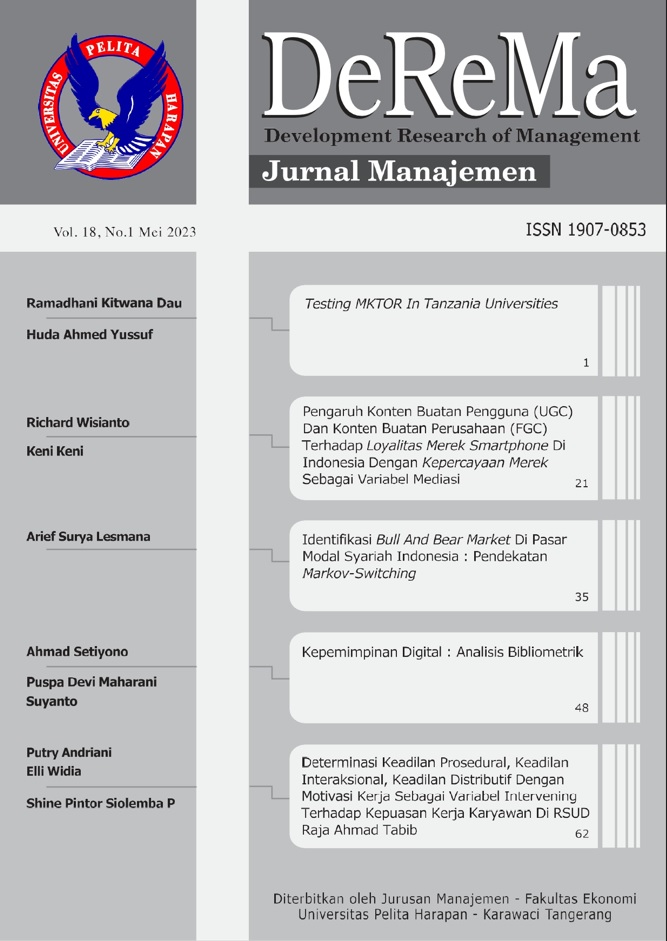IDENTIFIKASI BULL AND BEAR MARKET DI PASAR MODAL SYARIAH INDONESIA: PENDEKATAN MARKOV-SWITCHING [IDENTIFICATION OF THE BULL AND BEAR MARKET IN THE INDONESIAN SHARIA CAPITAL MARKET: THE MARKOV-SWITCHING APPROACH]
DOI:
https://doi.org/10.19166/derema.v18i1.6643Keywords:
Bullish, bearish, bull market, bear market, ISSI, JII, Islamic capital marketAbstract
The development of the Indonesian Islamic capital market cannot be separated from the bullish and bearish phenomena. Bullish and bearish conditions need special attention because they will affect investors’ decisions in buying, holding, or selling shares. This study aims to identify bullish and bearish conditions in the Indonesian Islamic capital market based on ISSI and JII data from January 2012 to December 2022. This study uses a quantitative approach with the Markov-Switching model technique. The result shows that in bullish conditions, ISSI can provide a return of 1.21% with a risk of 0.02%, while in bearish conditions ISSI can provide a return of -1.49% with a risk of 0.12%. Identification results on the ISSI data show that there were 101 bullish months with an expected duration of 9.5 months and 31 bearish months with an expected duration of 4.02 months. In addition, in bullish conditions, JII is able to provide a return of 0.17% with a risk of 0.02%, while in bearish conditions, JII can provide a return of -1.65% with a risk of 0.13%. Identification results on the JII data show that there were 90 bullish months with an expected duration of 5.93 months and 42 bearish months with an expected duration of 3.98 months.
Abstrak dalam Bahasa Indonesia. Perkembangan pasar modal syariah Indonesia tidak terlepas dari fenomena bullish dan bearish. Kondisi bullish dan bearish perlu mendapat perhatian khusus karena dapat mempengaruhi keputusan investor dalam pembelian, penahanan, atau penjualan saham. Penelitian ini bertujuan untuk mengidentifikasi kondisi bullish dan bearish di pasar modal syariah Indonesia berdasarkan data ISSI dan JII periode Januari 2012 hingga Desember 2022. Penelitian ini menggunakan pendekatan kuantitatif dengan Markov-Switching Model. Hasil penelitian menunjukkan bahwa pada kondisi bullish ISSI dapat memberikan tingkat pengembalian 1,21% dengan risiko 0,02%, sedangkan pada kondisi bearish ISSI dapat memberikan tingkat pengembalian -1,49% dengan risiko 0,12%. Pada data ISSI ditemukan 101 bulan bullish dengan rata-rata durasi 9,5 bulan dan 31 bulan bearish dengan rata-rata durasi 4,02 bulan. Selain itu pada kondisi bullish JII mampu memberikan tingkat pengembalian 0,17% dengan risiko 0,02%, sedangkan pada kondisi bearish, JII mampu memberikan tingkat pengembalian -1,65% dengan risiko 0,13%. Pada data JII ditemukan 90 bulan bullish dengan rata-rata durasi 5,93 bulan dan 42 bulan bearish dengan rata-rata durasi 3,98 bulan.
References
Agustin, I. N. (2019). The Integration of Fundamental and Technical Analysis in Predicting the Stock Price. Jurnal Manajemen Maranatha, 18(2), 93-102. https://doi.org/10.28932/jmm.v18i2.1611
Ariyani, F. D., Warsito, B., & Yasin, H. (2014). Pemodelan Markov-Switching Autoregressive. Jurnal Gaussian, 3(3), 381-390. http://ejournal-s1.undip.ac.id/index.php/gaussian
Caporale, G. M., & Zekokh, T. (2019). Modelling Volatility of Cryptocurrencies Using Markov-Switching GARCH Models. Research in International Business and Finance, 48(July 2018), 143-155. https://doi.org/10.1016/j.ribaf.2018.12.009
Defrizal, Sucherly, Wirasasmita, Y., & Nidar, S. R. (2015). The Determinant Factors of Sectoral Stock Return In Bullish And Bearish Condition at Indonesian Capital Market. International Journal of Scientific & Technology Research, 4(7), 209-214. www.ijstr.org
Do Prado, H. A., Ferneda, E., Morais, L. C. R., Luiz, A. J. B., & Matsura, E. (2013). On the Effectiveness of Candlestick Chart Analysis for the Brazilian Stock Market. Procedia Computer Science, 22, 1136-1145. https://doi.org/10.1016/j.procs.2013.09.200
Fabozzi, F. J., & Francis, J. C. (1979). Mutual Fund Systematic Risk for Bull and Bear Markets: An Empirical Examination. The Journal of Finance, 34(5), 1243-1250. https://doi.org/10.1111/j.1540-6261.1979.tb00069.x
Farhan, A., Djuwarsa, T., & Purbayati, R. (2022). Analisis Teknikal Pergerakan Saham PT Bank Jago Tbk dengan Menggunakan Indikator Candlestick dan Moving Average Convergence Divergence. Indonesian Journal of Economics and Management, 2(3), 517-525. https://doi.org/10.35313/ijem.v2i3.3783
Faridho, M. Al. (2021). The Corona Pandemic On Sharia Capital Market in Indonesia. IQTISHODUNA: Jurnal Ekonomi Islam, 10(2), 1-10. https://doi.org/10.36835/iqtishoduna.v10i2.864
Ganar, Y. B., Agrasadya, Dinantara, M. D., Apriansyah, M., Sahroni, Zulfitra, Sampurnaningsih, S. R., Rachmawaty, Noryani, Sari, W. I., Jati, W., Marjohan, M., Sarwani, Maddinsyah, A., & Sunarsi, D. (2020). The reaction of the sharia stock market in the early days of the Covid-19 pandemic in Indonesia. Systematic Reviews in Pharmacy, 11(11), 1516-1526. https://doi.org/10.31838/srp.2020.11.214
Hamilton, J. D. (1989). A New Approach to The Economic Analysis of Nonstationary Time Series and The Business Cycle. Econometrica, 57(2), 357-384.
Horton, M. J. (2009). Stars, Crows, and Doji: The Use of Candlesticks in Stock Selection. Quarterly Review of Economics and Finance, 49(2), 283-294. https://doi.org/10.1016/j.qref.2007.10.005
IDX. (2022). Indeks Saham Syariah. https://www.idx.co.id/id/idx-syariah/indeks-saham-syariah
Jones, C. P. (1998). Investment Analysis and Management (6th ed.). John Wiley & Sons Inc.
Khoerunnisa, A., Nur, I. M., & Arum, P. R. (2022). Metode Markov Switching Autoregressive (MSAR) untuk Peramalan Indeks Saham Syariah Indonesia (ISSI) (MSAR). Prosiding Seminar Nasional UNIMUS, 5, 608-623. https://prosiding.unimus.ac.id/index.php/semnas/article/view/1213
Kusuma, R. M. I., Ho, T.-T., Kao, W.-C., Ou, Y.-Y., & Hua, K.-L. (2019). Using Deep Learning Neural Networks and Candlestick Chart Representation to Predict Stock Market. 1-13. http://arxiv.org/abs/1903.12258
Luthfan, T. C., & Diana, N. (2022). Analisis Kinerja Indeks Saham Syariah Indonesia (ISSI) Sebelum dan Selama Pandemi COVID-19. Jesya (Jurnal Ekonomi & Ekonomi Syariah), 5(1), 793-800. https://doi.org/10.36778/jesya.v5i1.642
Mahastanti, L. A., Asri, M., Purwanto, B. M., & Junarsin, E. (2021). Capital Aset Pricing Model (CAPM) Revisited: The Context of Sharia-based Stocks with the Barakah Risk Premium Variable. Jurnal Keuangan Dan Perbankan, 25(2), 324-341. https://doi.org/10.26905/jkdp.v25i2.5572
Marshall, B. R., Young, M. R., & Cahan, R. (2008). Are Candlestick Technical Trading Strategies Profitable in the Japanese Equity Market? Review of Quantitative Finance and Accounting, 31(2), 191-207. https://doi.org/10.1007/s11156-007-0068-1
Mathlouthi, F., & Bahloul, S. (2022). Co-movement and Causal Relationships between Conventional and Islamic Stock Market Returns under Regime-Switching Framework. Journal of Capital Markets Studies, 6(2), 166-184. https://doi.org/10.1108/jcms-02-2022-0008
Muhamad Aldin Hidayat. (2022). Analisis Teknikal Pergerakan Harga Saham dengan Indikator Candlestick, Moving Average, dan Stochastic Oscillator. Jurnal Riset Manajemen Dan Bisnis, 36-42. https://doi.org/10.29313/jrmb.v2i1.906
Nurdany, A., Ibrahim, M. H., & Romadoni, M. F. (2021). the Asymmetric Volatility of the Islamic Capital Market During the Covid-19 Pandemic. Journal of Islamic Monetary Economics and Finance, 7(1), 185-202. https://doi.org/10.21098/jimf.v7i0.1312
Ong, E. (2017). Technical Analysis for Mega Profit. PT Gramedia Pustaka Utama.
Pourrafiee, M., Azizi, S. P., Larijani, M. M., & Pahlevannezhad, A. (2021). Comparing the Different Types of Markov Switching Model for Euro to Iran Rial Exchange Rate. Journal of Mathematics and Modeling in Finance, 1(1), 49-58. https://doi.org/https://doi.org/10.22054/jmmf.2020.54870.1014
Prayudi, A., & A, D. P. (2019). Analisis Keputusan Investasi (Buy and Sell) pada Perdagangan Saham PT Indah Kiat Pulp and Paper Tbk (Inkp) dengan Menggunakan Indikator Volume dan Dow Theory Tahun 2017. Jurnal Akuntansi Dan Pasar Modal, 2(1), 79-109.
Respati, P., Purwanto, B., & Irwanto, A. K. (2017). Estimasi Bullish dan Bearish dengan Model Perpindahan Markov dan Risiko Sistematis (beta) dengan Model Penilaian Modal Sharpe dalam Investasi Saham di Bursa Efek Indonesia, Tahun 2011 - 2016. Jurnal Manajemen Dan Organisasi, 8(3), 221-235. https://doi.org/10.29244/jmo.v8i3.22471
Sabila, F. H., Sumakdilaga, C., & Yuliafitri, I. (2019). Stock Selection dan Market Timing Ability Reksa Dana Syariah Saham di Indonesia (RETRACT). Atestasi : Jurnal Ilmiah Akuntansi, 2(1), 21-30. https://doi.org/10.57178/atestasi.v2i1.189
Sabrina, S., & Yessy, Y. (2019). Factors Affecting Risk Disclosure in Listed Indonesian Consumer Goods Industry Companies. DeReMa (Development Research of Management): Jurnal Manajemen, 14(2), 257. https://doi.org/10.19166/derema.v14i2.1435
Suryaputri, R. V., & Kurniawati, F. (2020). Analisis ISSI, IHSG, dan Nilai Tukar Rupiah Selama Pandemi Covid-19 Rossje. Prosiding Konferensi Nasional Ekonomi Manajemen Dan Akuntansi (KNEMA), Desember 2, 1-17. https://jurnal.umj.ac.id/index.php/KNEMA/
Usman, B. (2016). The Phenomenon of Bearish and Bullish in The Indonesian Stock Exchange. Esensi: Jurnal Bisnis Dan Manajemen, 6(2), 181-198. https://doi.org/10.15408/ess.v6i2.3750
Downloads
Published
Issue
Section
License
Authors who publish with this journal agree to the following terms:
1) Authors retain copyright and grant the journal right of first publication with the work simultaneously licensed under a Creative Commons Attribution License (CC-BY-SA 4.0) that allows others to share the work with an acknowledgement of the work's authorship and initial publication in this journal.
2) Authors are able to enter into separate, additional contractual arrangements for the non-exclusive distribution of the journal's published version of the work (e.g., post it to an institutional repository or publish it in a book), with an acknowledgement of its initial publication in this journal.
3) Authors are permitted and encouraged to post their work online (e.g., in institutional repositories or on their website). The final published PDF should be used and bibliographic details that credit the publication in this journal should be included.





